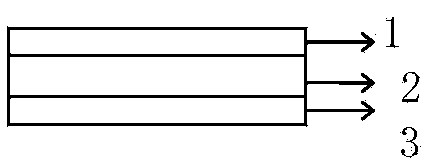Acrylic ester pressure-sensitive adhesive tape and preparation method thereof and lithium ion battery
A technology of acrylate and pressure-sensitive tape, which is applied to secondary batteries, secondary battery parts, circuits, etc., can solve the problem that acrylate pressure-sensitive tape is not resistant to electrolytes, etc., and achieves simple production, convenient use and safe use. effect of mission
- Summary
- Abstract
- Description
- Claims
- Application Information
AI Technical Summary
Problems solved by technology
Method used
Image
Examples
Embodiment approach
[0019] In a preferred embodiment of the present invention, for example, the acrylate monomers in the specific examples include (meth) laurate, isooctyl acrylate, acrylic acid and hydroxyethyl acrylate, and the prepared pressure-sensitive adhesive tape exhibits excellent The electrolyte resistance of the lithium-ion battery is only a little bit warped after being soaked in the electrolyte, and the bonding area is less than 5%.
[0020] Preferably, relative to 100 parts by weight of acrylate monomers, the acrylate monomers include 40 to 90 parts by weight of the first acrylate monomer, 1 to 40 parts by weight of the second acrylate monomer, 1 to 15 parts by weight parts of the third acrylate monomer.
[0021] Preferably, the crosslinking curing agent is selected from one or more of polyisocyanate compounds, curing agents with epoxy functional groups, metal ion chelates and aziridine curing agents. Further preferred crosslinking curing agents are polyisocyanate compounds. Throu...
Embodiment 1
[0044] (1): Preparation of acrylate copolymer:
[0045] Add 9.0 parts by weight of laurate (meth)acrylate, 29.2 parts by weight of isooctyl acrylate, 1.4 parts by weight of acrylic acid and 0.4 parts by weight of hydroxyethyl acrylate into the reactor and stir evenly, then add 45 parts by weight of In the mixed solvent that the toluene of ethyl acetate and 15 weight parts forms, and pass into nitrogen to discharge the oxygen in the reactor and material, and keep certain pressure, stir evenly, and heat up while stirring, the material temperature in the reactor Raise to 60°C, keep it, add 0.06 parts by weight of azobisisobutylcyanide initiator, then raise the temperature to 65°C~75°C to start the reaction, keep the temperature of the reaction kettle stable, and keep the reaction for 8~15 hours. After cooling to 35°C~45°C, the material is discharged for later use. The solid content is 60%+ / -5%, and the viscosity is 3000~15000cps.
[0046] (2): Preparation of release layer
[00...
PUM
| Property | Measurement | Unit |
|---|---|---|
| Thickness | aaaaa | aaaaa |
| Thickness | aaaaa | aaaaa |
| Viscosity | aaaaa | aaaaa |
Abstract
Description
Claims
Application Information
 Login to View More
Login to View More - R&D
- Intellectual Property
- Life Sciences
- Materials
- Tech Scout
- Unparalleled Data Quality
- Higher Quality Content
- 60% Fewer Hallucinations
Browse by: Latest US Patents, China's latest patents, Technical Efficacy Thesaurus, Application Domain, Technology Topic, Popular Technical Reports.
© 2025 PatSnap. All rights reserved.Legal|Privacy policy|Modern Slavery Act Transparency Statement|Sitemap|About US| Contact US: help@patsnap.com

